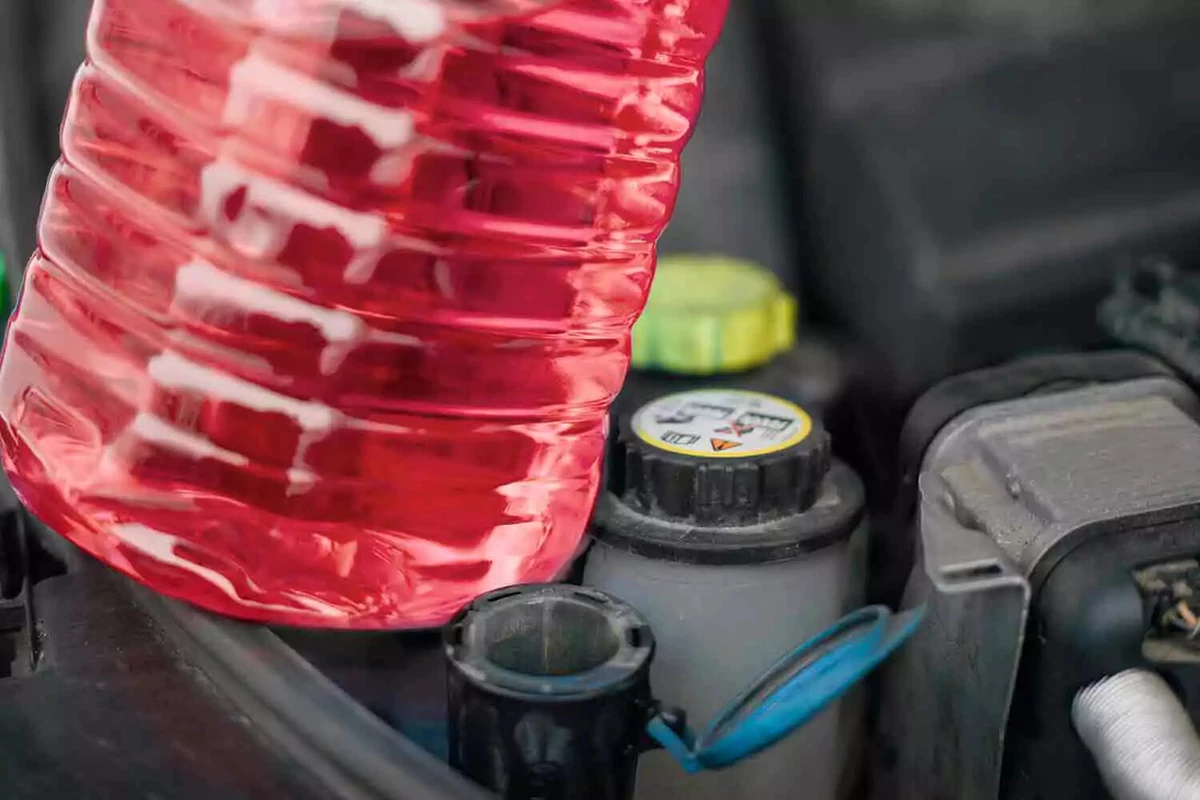What to Consider When Buying Engine Coolant

Organic acid technology (OAT) coolant is typically red, orange, yellow, or blue.
Concentrate vs. pre-mixed:
Antifreeze is the concentrated version of coolant. To create coolant, mix antifreeze with water using a 50/50 ratio. You can also purchase pre-mixed coolant, which is convenient. But mixing it yourself can save about 30 percent of the cost.
Amount:
Purchase enough coolant to finish the flush. Compact cars generally use five to seven quarts (1.25 to 1.75 gallons) per flush, while a mid-size SUV or sedan might need eight to ten quarts (2 to 2.5 gallons). Large trucks and SUVs can go through three to four gallons per flush. Check your owner’s manual for the amount required for your model.
Additives:
Some coolant formulations have additives to improve performance, increase lubrication, or reduce corrosion. While these aren’t usually necessary, they may be helpful for older engines or engines operating in harsh conditions.
Longer life:
Extended-life coolants don’t have to be flushed as frequently. They can last up to 100,000 miles.
Climate:
If you drive in an extreme climate, you may need enhanced protection against overheating or freezing. While a 50/50 mix is ideal for most climates, you might need a higher concentration of antifreeze.
Types of Engine Coolant

Always use an engine coolant grade that is engineered for use in your vehicle.
Can you choose a coolant by its color?
No. Don’t use color to make your choice. Check your owner’s manual for the correct specifications. Many people look at the color of the coolant currently in their vehicle’s reservoir and use that color to choose a new coolant. But that’s an inaccurate way of choosing. Coolants with the same color might have a different formulation. Also, manufacturers use a variety of colors, which can be misleading.
Can you mix coolant types?
Don’t mix coolant types. The combination can react poorly and reduce cooling protection. Only purchase the coolant type that’s recommended for your vehicle.
How much does a coolant flush cost?
The only expense for a DIY coolant flush is the antifreeze/water mixture. On average, expect to pay about $10 to $30 per gallon of coolant.You typically use between one and two gallons. In contrast, a mechanic will likely charge $100 to $150 for a coolant flush.
Here are the most common coolant types:
Inorganic acid technology (IAT):
This coolant, which is usually green, is used in American cars built before 2000. It has phosphates and silicates that prevent corrosion. However, it breaks down faster than newer formulations.
Organic acid technology (OAT):
This coolant is typically red, orange, yellow, or blue. It’s used in many of today’s vehicles, especially models from Honda, Toyota, and GM. OAT uses organic acids instead of phosphates and silicates, resulting in more extended protection.
Hybrid organic acid technology (HOAT):
HOAT is a combination of IAT and OAT formulations, which contain silicates that provide corrosion protection and organic acids for longer-term protection. This type of coolant—often orange, yellow, or turquoise—is used in American and European cars.
Phosphate-free organic acid technology (P-OAT):
This formulation is purple, pink, or blue. Owners of Asian or European vehicles, such as Audi, Mercedes-Benz, and Volkswagen, used P-OAT. The formulation, which is free from silicates and phosphates, is designed to enhance the protection of aluminum engine components.
Nitrate-free organic acid technology (N-OAT):
Many heavy-duty trucks and European vehicles rely on this coolant, which is usually purple or pink. There are no nitrates or corrosive additives in N-OAT. It’s best suited for diesel engines.
Silicated organic acid technology (Si-OAT):
Also pink or purple, Si-OAT is found in many German vehicles. It involves combining silicates with organic acids for corrosion protection.
Parts Related to a Coolant Flush

A properly-sized drain pan is a must have.
To perform a coolant flush, you only need basic tools and equipment—most of which you probably already have. Gather together distilled water, a floor jack, a drain pan, a wrench or pliers, and a funnel to get started.
See our detailed step-by-step guide and video about how to do a coolant flush.
When you perform a coolant flush, also conduct a complete inspection of the cooling system. The inspection might reveal the need for new hoses. Worn or cracked coolant hoses can leak, making it harder to keep the engine at an appropriate temperature.
It’s also a good time to check the radiator for damage. If it’s dirty, hose it down to increase efficiency. Look at the radiator cap for any signs of damage as well. If it doesn’t create a good seal, it needs to be replaced. The cap is responsible for holding the right amount of pressure.
If you have any other cooling system issues, we recommend that you inspect the water pump, thermostat, and heater core as well.
Share your feedback
This article is meant to provide general guidance only. Automotive maintenance, repair, upgrade, and installation may depend on vehicle-specifics such as make and model. Always consult your owner's manual, repair guide for specific information for your particular vehicle and consider a licensed auto-care professional's help as well, particularly for advance repairs.

















